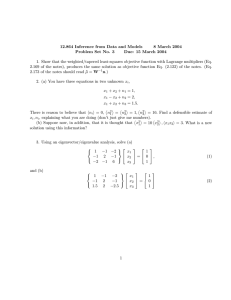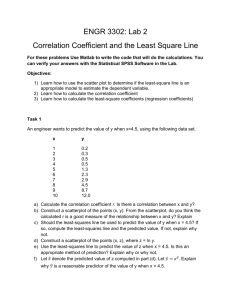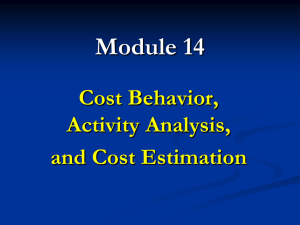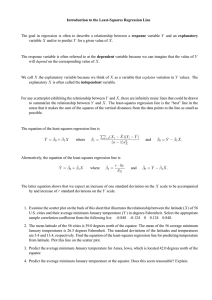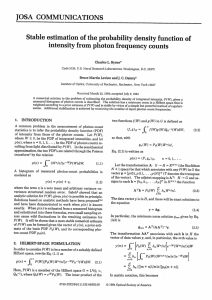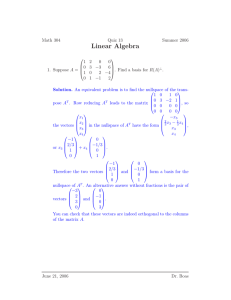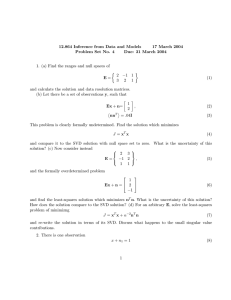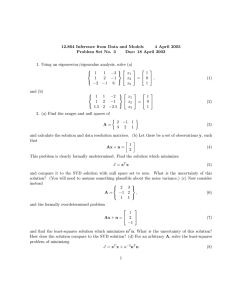Document
advertisement
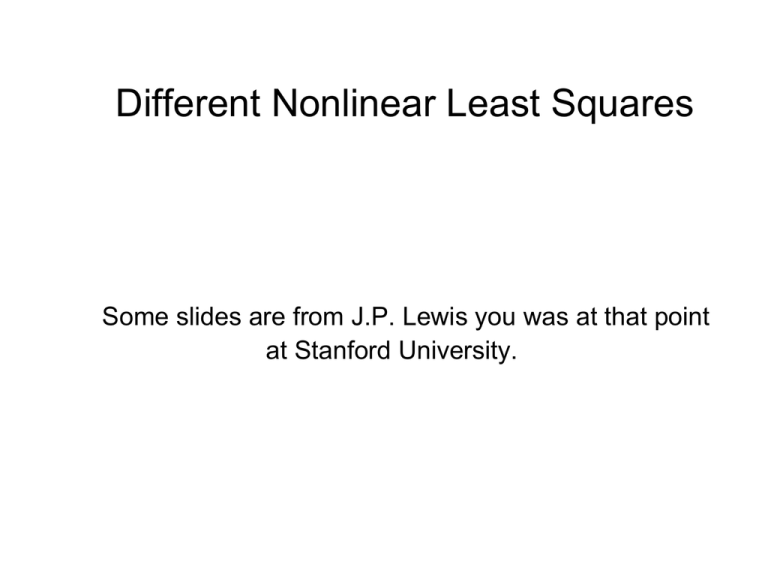
Different Nonlinear Least Squares
Some slides are from J.P. Lewis you was at that point
at Stanford University.
Setup
• Let f be a function such that
a ∈ R n → f (a, x ) ∈ R
where x is a vector of parameters
• Let {ak,bk} be a set of measurements/constraints.
We fit f to the data by solving:
min x
1
2
(
(
)
)
b
−
f
a
,
x
∑ k
k
2 k
Regularized Least-Squares
or
min x
∑ rk
k
2
with rk = bk − f (a k , x )
Approximation using Taylor series
( )
1 T
T
E (x + h ) = E (x ) + ∇E (x ) h + h H E (x ) h + O h
transposed !! 2
T
∂ 2 rj
∂rj
1 m 2
with E (x ) = ∑ rj , J = and H r j = dx_i dx_kT
2 j =1
∂xi
∂xi
m
∇E = ∑ r j ∇r j = J T r
j =1
m
m
m
H E = ∑ ∇rj ∇rj + ∑ rjH rT = J T J + ∑ rjH rT
j =1
Regularized Least-Squares
T
j =1
j
symmetric matrix
j =1
j
23
Existence of minimum
In general converges to a local minima.
A local minima is characterized by:
1.
2.
∇E (x min ) = 0
h H E (x min ) h ≥ 0, for all h small enough
(e.g. H E (x min ) is positive semi - definite)
T
Regularized Least-Squares
T
Existence of minimum
E (x )
1
T
E (x min + h ) ≈ E (x min ) + h T H E (x ) h
2
x min
Regularized Least-Squares
A non-linear function for the example:
the Rosenbrock function
z = f ( x, y ) = (1 − x 2 ) 2 + 100( y − x 2 ) 2
Global minimum at (1,1)
Regularized Least-Squares
Overview of different LS type algo.
•
•
•
•
Steepest (gradient) descent
Newton’s method
Gauss-Newton’s method
Levenberg-Marquardt method
Regularized Least-Squares
Gradient descent algorithm
• Start at an initial position x0
• Until convergence
– Find minimizing step dxk
using a local approximation of f
– xk+1=xk+ dxk
Produce a sequence x0, x1, …, xn such that
f(x0) > f(x1) > …> f(xn)
Regularized Least-Squares
Steepest (gradient) descent
x k +1 = x k − α∇E (x k )
Step
where
α
is chosen such that:
f (x k +1 ) < f (x k )
using a line search algorithm:
minα f ( k x k − α∇E (x k ))
Regularized Least-Squares
xk
x1
x2
Regularized Least-Squares
x min
∇E (x k )
x k +1
xk
x1
x2
Regularized Least-Squares
x min
∇E (x k )
x k +1
In the plane of the
steepest descent direction
x k +1
Regularized Least-Squares
xk
Rosenbrock function (1000 iterations)
Regularized Least-Squares
Newton’s method
• Step: second order approximation
E (x k + h ) ≈ N (h ) = E (x k ) + ∇E (x k )
T
1 T
T
h + h H E (x k ) h
2
At the minimum of N
∇N (h ) = 0 ⇒ ∇E (x k ) + H E (x k )h = 0
⇒ h = −H E (x k ) ∇E (x k )
−1
x k +1 = x k − H E (x k )−1 ∇E (x k )
Regularized Least-Squares
1
T
T
E (x k ) + ∇E (x k ) h + h T H E (x k ) h
2
xk
x1
x2
Regularized Least-Squares
x min
- H E (x k ) ∇E (x k )
−1
x k +1
Problem
• If H E (x k ) is not positive semi-definite, then - H E (x k )−1 ∇E (x k )
is not a descent direction: the step increases the error
function
• Uses positive semi-definite approximation of Hessian
based on the Jacobian
(quasi-Newton methods)
Regularized Least-Squares
Gauss-Newton method
Step: use
x k +1 = x k − H E (x k )−1 ∇E (x k )
with the approximate Hessian
m
H E = J T J + ∑ rjH rT ≈ J T J
j =1
j
Advantages:
• No second order derivatives
• J T J is positive semi-definite
Regularized Least-Squares
Rosenbrock function (48 evaluations)
Regularized Least-Squares
Levenberg-Marquardt algorithm
• Blends Steepest descent and Gauss-Newton
• At each step solve, for the descent direction h
(J
T
J + λI ) h = −∇E (x k )
if λ large
h ∝ −∇E (x k )
(steepest descent)
if λ small
h ∝ −(J J ) ∇E (x k )
T
Regularized Least-Squares
−1
(Gauss - Newton)
Managing the damping parameter λ
• General approach:
– If step fails, increase damping until step is successful
– If step succeeds, decrease damping to take larger
step
• Improved damping
(J
T
J + λdiag(J T J ) ) h = −∇E (x k )
Regularized Least-Squares
Rosenbrock function (90 evaluations)
Regularized Least-Squares
